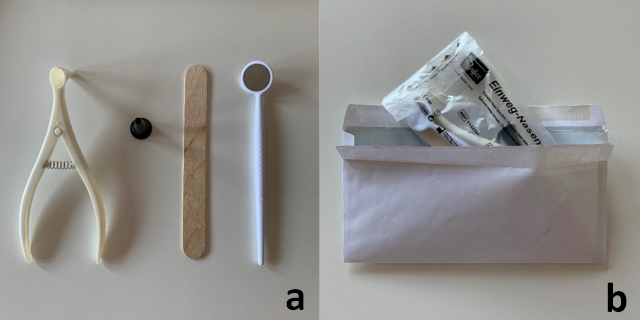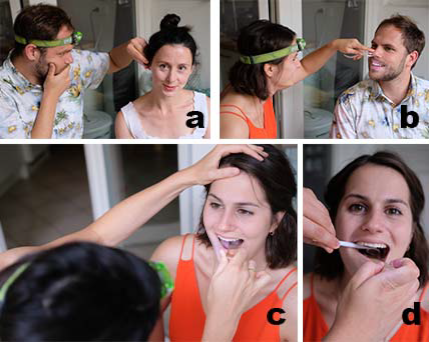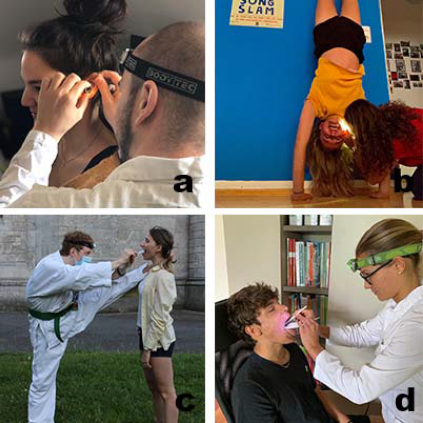Digital practical course of otorhinolaryngology and examination technique “to go”
Stefan Kaulitz 1Jonas Engert 1
Carolin Roos 1
Maike Filsinger 1
Sarah König 2
Stephan Hackenberg 1
1 Universitätsklinikum Würzburg, Klinik und Poliklinik für Hals-, Nasen- und Ohrenkrankheiten, plastische und ästhetische Operationen, Würzburg, Germany
2 Universitätsklinikum Würzburg, Institut für Medizinische Lehre und Ausbildungsforschung, Würzburg, Germany
Abstract
Objective: The development of presentation-free teaching formats for practical exercises is a particular challenge. The objective of the presented project was the implementation of the practical course in otorhinolaryngology for learning examination techniques through digital distance learning.
Methods: Disposable instruments for a comprehensive otorhinolaryngologic examination were purchased and made available to the students. The necessary light sources were everyday sports headlamps or flashlight constructions. The theoretical basics were taught using the learning platform CaseTrain, including photographic, audio and video material. Corresponding success controls in the sense of a digital short test were integrated here. In addition, video tutorials were used to present the examinations to be imitated in detail. In order to increase motivation, a creative photo competition was also announced, in which the practical tasks that were finally carried out independently were checked.
Results: All students of the semester received a set of instruments for independent practical training. The entrance exam was passed by all students, and at least one photo was received from all students, many of which were particularly creative in the competition.
Conclusion: The presented concept is a possibility to convert practical teaching formats into a digital presence-free concept. It included the teaching and testing of basic knowledge, instructions for practical exercises, the independent performance of subject-specific examination techniques and an increase in motivation and simultaneous control through gamification. We consider this teaching principle to be an attractive option for future “Flipped Classroom” concepts with a gradual resumption of face-to-face teaching.
Keywords
ENT, digital teaching, examination practical, propaedeutics, tutorial
1. Introduction
The SARS-CoV 2 pandemic has challenged medical teaching, but also left it highly open to new development opportunities [1], [2]. In particular, teaching formats that include practical exercises were difficult to replace by digital distance learning and corresponding examinations [3]. In the following article we would like to present a concept for the conversion of a practical course for learning ENT-examination techniques with an upstream entrance exam.
2. Project description
Due to the strict contact restrictions in Bavaria, the ENT practical course as part of the curricular teaching was excluded as a classroom event. The examinations in the field of otorhinolaryngology require special instruments as well as a person to be examined (e.g. peer). Disposable instruments were procured via online trading and an examination kit was compiled for the students. It included a nasal speculum, an ear speculum, a mouth spatula and a laryngeal mirror (cost: 1 €/student; see figure 1 [Fig. 1], point a). The students could use existing headlamps or flashlight constructions as the required light source (see figure 2 [Fig. 2]).
Figure 1: Examination kit for learning a comprehensive otorhinolaryngologic mirror examination in the context of digital distance learning - The examination kit contained the following disposable instruments: a nasal speculum, an ear speculum, a mouth spatula and a laryngeal mirror (a). The instruments could be picked up personally or delivered by mail (b).
Figure 2: Exemplary performance of a mirror examination of ENT-experienced PJ students with the examination kit - By using an external light source (e.g. headlamp), the examination kit enabled a professional otoscopy (a), anterior rhinoscopy (b), oral cavity inspection (c) and indirect laryngoscopy (d) to be performed. The independent performance of the examination methods was achieved by imitating the video tutorials provided.
The teaching unit started with an introductory information video about the structure and procedures of the digital lab.
The actual propaedeutics lecture and the otherwise orally tested entrance exam were replaced by e-learning cases using the learning platform “CaseTrain” [4]. This was originally developed for practical patient cases with integrated test results. Photo, audio and video material can be integrated. The interdisciplinary propaedeutic cases developed by lecturers, physicians and advanced students (practical year) contained ten test questions (pass mark 60%) on basic ENT knowledge and examination techniques. Specially created examination videos (tutorials) served the students as detailed preparation for the ENT examination, which they had to perform independently. In order to increase the motivation for learning in asynchronous teaching, a photo competition was announced, which at the same time served as a control for the practical tasks (see figure 3 [Fig. 3]). For this purpose, only pictures for which a written declaration of consent was available were used (voluntary). Possible problems that could not be solved during the examination exercises were dealt with in subsequent video conferences.
Figure 3: Examples of the contributions submitted by the students in the photo competition - Gamification was used to control the implementation of the examination methods. Otoscopy (a+b), oral inspection and indirect laryngoscopy (c+d) were presented in different ways. This method also served to increase the motivation of the students, who provided proof of work either in the most precise (a+d) or creative (b+c) way.
3. Results
The examination kits were picked up personally by almost all students at the clinic's teaching office. A few students who spent the semester outside of Würzburg either took care of the examination material themselves or received the kits by mail (see figure 1 [Fig. 1], point b).
The entrance examination was passed by all students. A photograph of the examination exercises was also received from all students. Figure 3 [Fig. 3] and figure 4 [Fig. 4] show some implementations in the students' own design environment.
Figure 4: Winner of the photo competition - Due to the creative realization of the work order in combination with the allusion to the SARS-CoV-2 pandemic and the required minimum distance, the interprofessional jury decided in favor of this photo.
4. Discussion
Teaching concepts based on e-learning for ENT practical courses are rare, although the need to establish digital teaching formats has already been addressed at German ENT university hospitals for both student teaching [5] and specialist training [6].
The declared goal of the project was to develop a teaching and examination concept for the time without classroom teaching. The format of the e-learning cases, which was evaluated by students as extremely effective and useful with regard to “blended learning” [7], [8], in combination with the provision of one-time instruments, made it possible to implement the above-mentioned aspects simultaneously.
The developed format should include
- teaching and testing of basic knowledge,
- instructions for practical exercises (model learning via video tutorials),
- independent execution of the exercises by imitation,
- motivation and implementation control through gamification (photo competition).
In addition, it can provide the basis for future teaching according to the principle of the “flipped classroom”, if face-to-face teaching in a hybrid version can be resumed with a sense of proportion and sharing during the low-prevalence phase of SARS-CoV-2. The “Flipped Classroom” integrates didactic content more effectively into the everyday medical life of students and teachers [9].
Video demonstrations can be used efficiently for learning practical medical skills [10], [11]. Studies that compare learning an ENT examination by face-to-face teaching with digital teaching have not been described in the literature so far. A study with Canadian medical students on the management of epistaxis showed a significantly better performance of a computer-based teaching module compared to text-based methods [12]. A comparison of knowledge transfer on ENT emergencies between traditional face-to-face teaching and e-learning based methods showed no significant difference in quality [13]. These data show that teaching clinical skills can also be sensibly done digitally. If face-to-face teaching is resumed, the CaseTrains presented here, including preliminary exercises of examination techniques in connection with the subsequent practical training in otorhinolaryngology as a “Flipped Classroom”, could exploit new potentials [14].
Digital teaching content is the mainstay in the teaching of theoretical fundamentals, on the basis of which problem-oriented and case-based face-to-face sessions are then developed [15]. In the future, the effectiveness of this teaching must be evaluated on the basis of the examination results and the practical competence (e.g. OSCE) of the students.
The choice to motivate through gamification (here photo competition) and to control the execution of the practical exercises proved itself and corresponded with the experiences reported in the literature [16].
Competing interests
The authors declare that they have no competing interests.
References
[1] Ferrel MN, Ryan JJ. The Impact of COVID-19 on Medical Education. Cureus. 2020;12(3):e7492. DOI: 10.7759/cureus.7492[2] Rose S. Medical Student Education in the Time of COVID-19. JAMA. 2020;323(21):2131-2132. DOI: 10.1001/jama.2020.5227
[3] Moran J, Briscoe G, Peglow S. Current Technology in Advancing Medical Education: Perspectives for Learning and Providing Care. Acad Psychiatry. 2018;42(6):796-799. DOI: 10.1007/s40596-018-0946-y
[4] Hörnlein A, Ifland M, Kluegl P, Puppe F. Konzeption und Evaluation eines fallbasierten Trainingssystems im universitätsweiten Einsatz (CaseTrain). GMS Med Inform Biom Epidemiol. 2009;5(1):Doc07. DOI: 10.3205/mibe000086
[5] Freiherr von Saß P, Klenzner T, Scheckenbach K, Chaker A. Einsatz von E-Learning an deutschen Universitäts-HNO-Kliniken. Laryngorhinootologie. 2017;96(03):175-179. DOI: 10.1055/s-0042-117640
[6] Shabli S, Heuermann K, Leffers D, Kriesche F, Abrams N, Yilmaz M, Klussmann JP, Guntinas-Lichius O, Beule AG. Umfrage zum Bedarf einer e-Learning-Plattform für Ärzte in der HNO-Facharzt-Weiterbildung. Laryngorhinootologie. 2019;98(12):869-876. DOI: 10.1055/a-1025-2024
[7] Diessl S, Verburg FA, Hoernlein A, Schumann M, Luster M, Reiners C. Evaluation of an internet-based e-learning module to introduce nuclear medicine to medical students: a feasibility study. Nucl Med Commun. 2010;31(12):1063-1067. DOI: 10.1097/MNM.0b013e328340821f
[8] Huwendiek S, Muntau AC, Maier EM, Tönshoff B, Sostmann K. E-Learning in der medizinischen Ausbildung. Monatsschr Kinderheilkunde. 2008;156(5):458-463. DOI: 10.1007/s00112-008-1737-4
[9] Tolks D, Schäfer C, Raupach T, Kruse L, Sarikas A, Gerhardt-Szép S, Kllauer G, Lemos M, Fischer MR, Eichner B, Sostmann K, Hege I. An introduction to the inverted/flipped classroom model in education and advanced training in medicine and in the healthcare professions. GMS J Med Educ. 2016;33(3):Doc46. DOI: 10.3205/zma001045
[10] Hansen M, Oosthuizen G, Windsor J, Doherty I, Greig S, McHardy K, McCann L. Enhancement of medical interns' levels of clinical skills competence and self-confidence levels via video iPods: pilot randomized controlled trial. J Med Internet Res. 2011;13(1):e29. DOI: 10.2196/jmir.1596
[11] Padmavathi R, Omprakash A, Kumar AR. Video demonstration as a teaching-learning method for a core clinical skill among undergraduate medical students: An interventional study. Nat J Physiol Pharm Pharmacol. 2019;9:547-550.
[12] Glicksman JT, Brandt MG, Moukarbel RV, Rotenberg B, Fung K. Computer-assisted teaching of epistaxis management: a Randomized Controlled Trial. Laryngoscope. 2009;119(3):466-472. DOI: 10.1002/lary.20083
[13] Alnabelsi T, Al-Hussaini A, Owens D. Comparison of traditional face-to-face teaching with synchronous e-learning in otolaryngology emergencies teaching to medical undergraduates: a randomised controlled trial. Eur Arch Otorhinolaryngol. 2015;272(3):759-763. DOI: 10.1007/s00405-014-3326-6
[14] Bergmann J, Sams A. Flip your classroom: Reach every student in every classroom every day. Washington, DC: International Society for Technology in Education; 2012.
[15] Prober CG, Heath C. Lecture halls without lectures--a proposal for medical education. N Engl J Med. 2012;366(18):1657-1659. DOI: 10.1056/NEJMp1202451
[16] Lewis ZH, Swartz MC, Lyons EJ. What's the Point?: A Review of Reward Systems Implemented in Gamification Interventions. Games Health J. 2016;5(2):93-99. DOI: 10.1089/g4h.2015.0078




